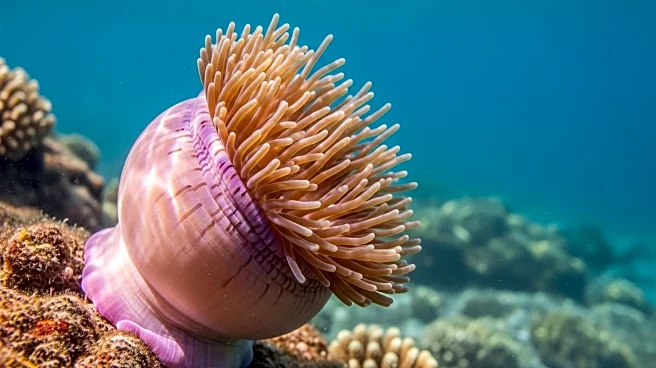What's Happening?
Researchers have identified the starlet sea anemone, a marine creature found along the U.S. and British coasts, as a potential key to understanding and possibly extending human longevity. This sea anemone, known scientifically as Nematostella vectensis, possesses remarkable regenerative abilities, allowing it to regenerate entire body parts. A study published in Science Advances by researchers from the University of Vienna has highlighted the anemone's ability to produce multipotent stem cells, which are crucial for its regenerative capabilities. These stem cells enable the anemone to continuously generate new cells, a process that could provide insights into combating human aging. The study also identified specific genes, such as nanos and piwi, which play a significant role in the anemone's regenerative process. Using CRISPR technology, scientists mutated the nanos2 gene, which disrupted the anemone's regenerative abilities, underscoring the gene's importance in maintaining its 'immortality.'
Why It's Important?
The discovery of the starlet sea anemone's regenerative abilities could have profound implications for human health and longevity. If scientists can harness the mechanisms behind the anemone's ability to regenerate and remain youthful, it could lead to breakthroughs in regenerative medicine and anti-aging therapies. This research could pave the way for developing treatments that enhance human regenerative capabilities, potentially leading to longer, healthier lives. The study's findings also contribute to the broader understanding of stem cell biology, which is crucial for advancing medical research and developing new therapeutic strategies. The potential to manipulate similar genetic pathways in humans could revolutionize how age-related diseases and injuries are treated, offering hope for improved quality of life as people age.
What's Next?
Future research will likely focus on further understanding the genetic and cellular mechanisms that enable the starlet sea anemone's regenerative abilities. Scientists may explore the possibility of applying these findings to human biology, potentially leading to the development of new regenerative therapies. Continued studies could involve experimenting with similar genetic pathways in human cells to assess their potential for enhancing regenerative capabilities. Additionally, ethical considerations and safety assessments will be crucial as researchers explore the implications of applying these biological insights to human health. Collaboration between geneticists, biologists, and medical researchers will be essential to translate these findings into practical applications that could benefit human health and longevity.
Beyond the Headlines
The research into the starlet sea anemone's regenerative abilities raises important ethical and philosophical questions about the pursuit of human longevity. As scientists explore the potential to extend human life, considerations around the societal and environmental impacts of increased human lifespan will become increasingly relevant. The possibility of significantly extending human life could lead to shifts in population dynamics, resource allocation, and healthcare systems. Additionally, the ethical implications of genetic manipulation and the potential for unintended consequences must be carefully considered as research progresses. These broader implications highlight the need for ongoing dialogue and ethical frameworks to guide the responsible development and application of regenerative technologies.










